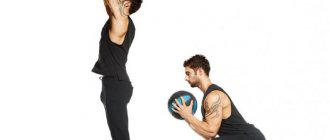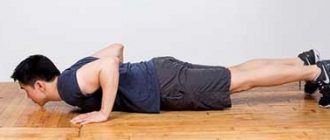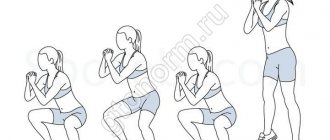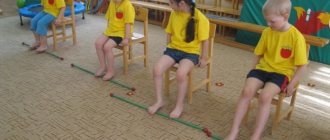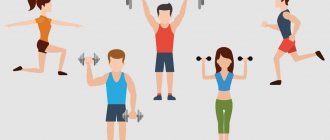The essence of the isometric exercise system
Isometric training is a type of physical activity in which the length of the working muscle does not change and the joint remains immobilized. Due to this feature of tension without movement, isometric exercises have another name - static. They are used to increase strength and overcome sticking points. The goal of these exercises is to spend maximum effort to hold or resist any object over a short period of time - 6-12 seconds. Unlike dynamic loads, repeated a certain number of times, when reproducing static complexes, it is not the quantity that is important, but the duration of holding the body in a certain position and the feeling of one’s body.
Advantages and disadvantages of isometrics
Regular performance of isometric static exercises allows you to:
- quickly develop muscles, strengthen ligaments and tendons;
- use time rationally and do not overwork, since the duration of the workout should not exceed 20 minutes. As practice shows, it takes only a few minutes for the muscles to engage in work, and they do not have time to get very tired, which allows you to reduce the interval necessary for rest and conduct training on a daily basis. In contrast to this type of load, a regular workout, lasting 1-2 hours, requires at least 24-36 hours. proper rest, which lengthens the total time required to achieve the goal;
- do without the use of special equipment, and what may be needed during classes is quite affordable or is at hand;
- conduct training anywhere - at work, in transport, at home, while walking;
- strengthen the spine during the treatment of osteochondrosis or post-traumatic rehabilitation therapy. In this case, the exercises are performed under the supervision of a doctor.
Despite all the advantages, performing only isometric exercises is not a full-fledged workout, because:
- promotes shortening of muscles;
- causes a reduction in muscle motor abilities, reduces movement speed;
- do not develop coordination.
For these reasons, isometric exercise must be combined with dynamic exercises, the advantages of which compensate for the disadvantages of static exercises. It is advisable to do the exercises under the supervision of a trainer for the first time - until the sequence of execution is completely correctly mastered.
Differences between isometric and isotonic exercises
The main difference between isometric and isotonic exercises is the absence/presence of changes in muscle length during its work. Isometric training allows you to strengthen your muscles without increasing their volume or moving your joints. An indicative exercise representing static training is the “plank”. In the process of its implementation, there is a contraction of muscles that are under tension, in contrast to isotonic exercises such as “boat” or “bow pose”, during which the length of the muscle increases.
Reverse plank on straight arms
In addition to the plank, the complex of basic isometric exercises includes:
- traction in 3 positions;
- press in 3 positions;
- squats in 3 positions;
- raising on toes;
- shoulder lifts and other activities.
What are the differences and similarities between isometric exercises and static ones?
In general, isometric exercises are one of many subtypes of static exercises, which also include yoga and Pilates. Isometric exercises are performed briefly with maximum muscle tension, static exercises are performed for a long time with “even” tension. The first ones develop muscle strength and strengthen ligaments and tendons (which is why they were previously called tendons), the second ones mainly provide endurance and general physical exercise.
In the process of performing static and isometric exercises, tension in the muscle fibers occurs, their temporary thickening and, as a result, compression of the vessels that supply blood to the muscles, and the occurrence of a relative lack of oxygen in the muscle cells. Hydrogen ions play an important role, stimulating the development of new blood vessels, connective tissue, the synthesis of contractile muscle molecules and the formation of neuromuscular connections.
Thus, for maximum benefits of body development, you need to combine statics, including isometric complexes, with dynamic strength exercises and aerobic exercise (running, swimming, aerobics).
The benefits of isometric exercises
By promoting the development of internal muscles, isometrics for strength development allows you to recruit slow-twitch muscle fibers that typically do not receive enough stress during regular strength training. For this reason, static training is included in physiotherapeutic programs aimed at restoring motor functions. In addition, they help improve the strength and elasticity of ligaments and tendons, manage your weight by burning fat and activating the functioning of blood vessels, and develop the ability to consciously control muscles and maintain balance.
Deadstop training
This is where the power generators come into conflict with the stretch reflex. If you use deadstop training techniques, you eliminate the effect of the stretch reflex. All that remains is your muscles and the power they can generate to move the weight. If you stop at the bottom of a squat and count to three before starting the rise, your leg muscles will have to rely only on their own power output. To a certain extent, this is a real test of strength.
Even if you are not a pure strength person, you will still benefit from the techniques of full stop training. As the central nervous system receives new stimuli, the muscles become larger and stronger. Here are some options for integrating deathstop training techniques into your training cycle.
Method 1: Squat Rack Press and Floor Press
Since we started this conversation with the bench press, I just have to return to this exercise. Both the squat rack press and the floor press are simple but very important exercises. The key is the pause at the bottom of each repetition, during which we release the accumulated energy. Because of this, the working weight may seem heavier and you will have to lose a couple of tens of kilograms. In this case, the hard truth is that all this time you have been deceiving yourself about progress.
For the first option, use a squat rack so that the bar of the bar is positioned above your chest. When performing the exercise, we pay all attention to the concentric phase of the movement. Since I'm under the bar, I perform the lift as quickly as possible and then lower the bar to the rack. Don't waste energy lowering the bar - I often use a controlled fall. Once the bar is back in the rack, release the bar, lower your arms to your sides, and get ready for the next rep. And so on until you finish the approach.
Bench press
The main goal is to generate maximum power, so forget about easy sets of 12-15 reps. I start with 4 reps and gradually reduce the number of reps per set to one or two. I recommend starting with five reps per set and working your way up to your heaviest set of two reps.
The technique of bench press on the floor is somewhat different from that described. Lie on the floor in a squat rack with the bar at a level where you can reach it. Remove the bar from the rack, lower it until your elbows touch the floor, pause, count to three and sharply lift the barbell. Make sure the pause is long enough to neutralize the effect of the reserve energy.
Method 2: Box/Bench Squats
Similar techniques can be successfully used for other muscle groups. For gym regulars, leg training often ranks second to the great and terrible bench press. Place a box or bench so that it does not interfere with your movements while you squat. At the lowest point, sit on the bench, keep your muscles toned, but come to a complete stop. Wait a couple of seconds, release any pent-up energy, and then rise up forcefully.
Place a box or bench so that it does not interfere with your movements while squatting
Heavy squats produce truly enormous amounts of power, and by eliminating the influence of the stretch reflex, you can increase your power output even further. This will inevitably lead to an increase in the volume of the leg muscles, since the muscles will actually have to do more work.
Method 3: Deadlift
It is no coincidence that this exercise was called a deadlift: it is performed from a complete stop! Similar to the squat rack bench press, the key to performing the exercise correctly is to come to a complete stop the moment the weight hits the ground. Use this moment to adjust your grip, leg position or body angle, and then perform the next row. If you need to lose weight, don't be shy. Your central nervous system will work better, and you will achieve tangible results faster.
Watch the pros deadlift. They perform movements quickly and accurately, even with heavy weights
Bodymaster.ru recommends Training Plans:
Attention ! All static exercises are performed while inhaling.
When analyzing how to do isometric exercises correctly, it should be noted that the effort must be increased gradually, performing 2-3 approaches and devoting time to completing each task:
- novice users - no more than 5-6 seconds;
- experienced – 10-12 seconds;
- the duration of maximum effort for both categories of users is 2-3 seconds.
The interval between approaches is no more than 1-2 minutes. In total, the total complexity of the workout should not exceed 15-20 minutes.
Safety regulations"
When performing this complex, the following rules are observed:
- The optimal training time is morning and afternoon. Large static loads performed in the evening do not allow you to fall asleep for a long time;
- training begins with stretching, preparing the muscles for maximum loads;
- While performing movements, you need to breathe easily and calmly. It will be useful to ventilate the room immediately before training;
- To achieve maximum effect, try to do each exercise technically correctly from the very beginning. For this reason, it is recommended to perform new exercises under the supervision of a trainer;
- during classes, concentrate as much as possible on the body, listening to how the load is applied, building up strength as the work is done;
- You need to start the exercise while inhaling, make any movements smoothly, without jerking;
- exercise regularly, performing 3-4 approaches for each muscle group 5 days a week;
- observe pauses between approaches to restore breathing;
- feel pain in muscles or ligaments, stop exercising;
- After training, it is recommended to take a contrast shower.
Attention ! Performing isometric exercises can cause an increase in blood pressure (blood pressure), so if you experience a headache during exercise, you should stop training immediately.
Suitable equipment and popular exercise machines
The basic exercises included in the isometric training complex are performed with and without additional equipment. Special equipment used for training may include:
- Smith machine;
- horizontal bar;
- power frame;
- gymnastic belt;
- BOSU hemisphere trainer;
- balance board,
- Ultimate Power Frame
- and others.
3.1. Methods for developing flexibility
To develop and improve flexibility, it is methodically important to determine the optimal proportions in the use of stretching exercises, as well as the correct dosage of loads. If it is necessary to achieve a noticeable shift within 3-4 months, then the following ratios in the use of exercises are recommended: approximately 40% active, 40% passive and 20% static.
It is important to combine flexibility exercises with strength and relaxation exercises. It has been established that the integrated use of strength and relaxation exercises not only helps to increase the strength and elasticity of the muscles producing this movement, but also increases the strength of the muscular-ligamentous apparatus. In addition, when using relaxation exercises during the period of targeted development of mobility in the joints, the effect of training increases significantly (up to 10%).
When performing flexibility exercises in individual classes and throughout the year, you should increase the load by increasing the number of exercises and the number of their repetitions. The tempo for active exercises is 1 repetition per 1 s; for passive ones - 1 repetition in 1-2 s; “exposure” in static positions - 4-6 s.
It is recommended to perform flexibility exercises in one lesson in the following sequence: first, exercises for the joints of the upper extremities, then for the torso and lower extremities. When performing these exercises serially, relaxation exercises are given during rest periods.
There are different opinions on the number of classes per week aimed at developing flexibility. However, all experts agree that at the initial stage of working on developing flexibility, it is enough to exercise 2-3 times a week.
Flexibility exercises are performed in all parts of the training session. In the preparatory part of the lesson, they are used during warm-up, usually after dynamic exercises, gradually increasing the range of movements and the complexity of the exercises themselves.
In the main part, such exercises are performed in series, alternating with the work of the main focus, or simultaneously with strength exercises. If developing flexibility is one of the main objectives of a training session, then sometimes it is advisable to concentrate stretching exercises in the second half of the main part of the session, highlighting them as an independent “block” of load.
In the final part, stretching exercises are combined with relaxation exercises and self-massage.
At the same time, the effectiveness of the stretching exercises used depends on the focus of the training work performed in this lesson.
Before speed-strength work in the warm-up, it is advisable to include active dynamic stretching exercises, self-massage and shaking of the working parts of the body, as well as perform a series of 1-2 special preparatory stretching exercises during the work itself. This methodological approach is justified when training the start and starting acceleration or maximum speed in a 100 m run. In this case, after warming up, a series of runs from the start and on the run are performed in segments from 10 to 60 m. Before each series of speed exercises, active dynamic exercises are performed on stretching and relaxing the muscles of the legs and pelvis: various bends, swinging the legs, shaking the muscles, etc. A similar methodological technique for using stretching exercises is recommended when performing jumping exercises and in hand-to-hand combat training.
3.1.1. Method of combined development of strength and flexibility .
Particular attention should be paid to stretching muscles and ligaments when performing strength exercises, given their possible negative effect on flexibility. An undesirable decrease in muscle contractility from strength exercises can be overcome by three methodological techniques:
1. Consistent use of strength and flexibility exercises. Here it is possible to use both a direct sequence of using a set of exercises (strength + flexibility) and a reverse sequence (flexibility + strength). In the first case, under the influence of performing a series of strength exercises, mobility in working joints gradually decreases by 20-25%, and after performing a set of stretching exercises, it increases by 50-70% of the reduced level.
The reverse sequence of exercises is more preferable if it is necessary to perform strength exercises with a maximum range of motion, but strength capabilities will noticeably decrease.
2. Alternating use of strength and flexibility exercises (strength + flexibility + strength + ...) during one training session. With this option for constructing a lesson, a step-like change in the mobility of the working parts of the body occurs. After each strength exercise, flexibility decreases, and after stretching, it increases again with a general tendency for it to increase by the end of the session to 30-35% of the initial level.
3. Simultaneous (combined) development of strength and flexibility in the process of performing strength exercises.
In case of severe fatigue after performing large volumes of technical, strength, speed-strength loads, it is recommended to use “passive” dynamic stretching exercises. This is due to the fact that in conditions of severe muscle fatigue such exercises are not only more effective, but also less traumatic. Sets of passive exercises are best used at the end of the main or final parts of the lesson, as well as in the form of a separate “recovery” workout. After a large volume of endurance training, such as a long or tempo cross-country run, high volume of repetition or interval work, it is best to perform 5-6 light active dynamic stretches, being careful not to injure the fatigued muscles.
At the same time, it was noticed that, even after an intensive warm-up using mainly dynamic exercises, despite the increase in muscle temperature and the general increase in the amplitude of movements, the ligaments are not always prepared for the maximum range of speed-strength work. Therefore, sometimes a greater effect is achieved when building a warm-up based on static stretching exercises. This warm-up is recommended when improving hand-to-hand combat techniques.
You just need to always remember that you can stretch only after a good warm-up and you should not have severe pain, but only a feeling of slightly “stretched” muscles and ligaments.
3.1.2. Repeated stretch method
This method is based on the property of muscles to stretch much more with repeated repetitions of the exercise with a gradual increase in the range of movements. The exercises begin with a relatively small range of motion and gradually increase it by 8-12 repetitions to the maximum, or a limit close to it. Highly skilled athletes, for example, manage to continuously perform exercises at or near maximum amplitude up to 40 times. The limit for the optimal number of repetitions of an exercise is the beginning of a decrease in the range of movements or the occurrence of pain that must be avoided. The number of repetitions of exercises varies depending on the nature and focus of the exercise to develop mobility in a particular joint, the tempo of movements, the age and gender of those involved. Active dynamic exercises are usually performed at a higher tempo than all others, and their dosage depends significantly on the joint being worked and the training objectives.
When determining the maximum number of repetitions of exercises on any joint in one training session, you can adhere to the parameters given in Table 3. For teenagers, the number of repetitions is reduced by about 50-60%, and for women - by 10-15%. Passive dynamic exercises with a partner are performed at a slower pace with the same dosage. Dosage of performing flexibility exercises using the method of repeated stretching when solving various training problems (according to B.V. Sermeev, 1970).
Table 3
Maximum Exercise Reps Options
| № | Under development joints | Training Objectives | |
| Development of flexibility | Maintaining flexibility | ||
| 1. | Spinal column | 90-100 | 40-50 |
| 2. | Brachial | 50-60 | ZO-40 |
| 3. | Radiocarpal | 30-35 | 20-25 |
| 4. | Hip | 60-70 | 30-40 |
| 5. | Knee | 20-25 | 20-25 |
| 6. | Ankle | 20-25 | 10-15 |
But the most effective is the use of complexes of several active dynamic stretching exercises, 8-15 repetitions of each of them. During one training session there may be several such series of exercises, performed with little rest or interspersed with exercises of a different focus (usually technical, strength or speed-strength). In this case, it is necessary to ensure that the muscles do not “freeze.”
3.1.3. Static stretch method
This method is based on the dependence of the amount of stretching on its duration. First you need to relax, and then perform the exercise, holding the final position for 10 - 15 seconds to several minutes. Sets of static stretching exercises can also be performed with a partner. Isometric stretching is a type of static stretching in which you add resistance to stretched muscle groups by contracting them isometrically. For example, you put your foot against a wall, trying to move it, knowing that this will not happen. No movement occurs, but the muscle tenses. This type of stretching is more effective for developing passive flexibility and muscle strength. It can be performed with the help of a partner, equipment, your own hands, using a wall, floor, supports.
This type of exercise is not recommended for children and older people because... in the former, the bones are not yet strong enough, and in the latter, they can be very fragile, because the load on the bones, with such stretching, is very high. There are several methods of isometric stretching:
1. take a position as for passive stretching, 7-15 s of isometric effort, 20 s of rest and relaxation.
2. take the position, 7-15 s isometric effort, 2-3 s softening, with the help of a partner, hands or equipment, smoothly bring to a more stretched position for 10-15 s. Then rest for 20 s.
3. take a position, 7-15 s isometric tension of the stretched muscles, 7-15 s isometric tension of the antagonist muscles (muscles performing the opposite action to the first). For example, biceps and triceps are antagonistic muscles. The biceps flexes the arm, the triceps extends it.
It is recommended to do 1 to 5 repetitions for each muscle group. Isometric stretching should not be performed more than once every 24-36 hours. It is best to alternate between static and passive stretching every other day. There are a number of recommendations that should not be neglected when training flexibility. They greatly increase efficiency and reduce the possibility of injury.
If you are faced with the task of increasing flexibility, then stretching exercises must be performed daily. To maintain flexibility at the level already achieved, you can reduce the number of classes to 2-3 per week. At the same time, it is also possible to reduce the volume of stretching exercises performed in each training session. Typically, during the day, a total of 15 to 60 minutes are spent doing stretching.
3.1.4. Stretching
Stretching is a system of exercises that develop flexibility and help increase muscle elasticity. The term stretching comes from the English word stretching - to pull, stretch.
During static stretching exercises, the student takes a certain position and holds it for 15 to 60 seconds, while he can strain the stretched muscles.
The physiological essence of stretching is that when muscles are stretched and held in a certain position, the processes of blood circulation and metabolism are activated in them.
In the practice of physical education and sports, stretching exercises can be used: in a warm-up after warm-up exercises as a means of preparing muscles, tendons and ligaments for a volumetric or high-intensity training program; in the main part of the lesson (lesson) as a means of developing flexibility and increasing the elasticity of muscles and ligaments; in the final part of the lesson as a means of recovery after high loads and prevention of injuries to the musculoskeletal system, as well as relieving pain and preventing seizures.
There are various stretching options. The most common sequence of exercises is the following: muscle contraction phase (strength or speed-strength exercise) lasting 1-5 s, then muscle relaxation for 3-5 s and then stretching in a static position for 15 to 60 s. Another method of stretching is also widely used: dynamic (springy) exercises, performed in the warm-up or the main part of the lesson, end with holding a static pose for a while in the last repetition.
The duration and nature of the rest between exercises are individual, and the pause itself for exercisers can be filled with slow running or active rest.
The stretching technique is quite individual. However, certain training parameters can be recommended:
1. duration of one repetition (holding the pose) from 15 to 60 s;
2. the number of repetitions of one exercise is from 2 to 6 times, with rest between repetitions of 10-30 s;
3. the number of exercises in one complex from 4 to 10;
4. the total duration of the entire load is from 10 to 45 minutes; nature of rest - complete relaxation, jogging, active rest.
3.1.5. Yoga
Of the 84,000 yoga poses, only about 84 basic asanas are performed. A simple visual analysis shows that about 90% of the main asanas are aimed at developing the flexibility of one or another part of the musculoskeletal system.
Compared to other methods of developing flexibility, yoga exercises have a number of advantages. Firstly, yoga exercises are not performed with such great muscle tension; they are devoid of unnecessary damaging effects on body tissue. Yoga exercises actively involve proprioceptors (nerve endings in tendons, ligaments and joint capsules) and interoreceptors (nerve endings of internal organs), which, according to modern medicine, is an important factor in health.
Secondly, the body of yogis is not distinguished by overly developed muscles. Yogis have a slender youthful body without excess fat deposits.
Thirdly, yoga exercises can be performed taking into account their individual capabilities. Yoga poses, when correctly selected and applied, have an effect on all organs and systems of the body, without causing blood outflow from them, but, on the contrary, improving its circulation.
Fourthly, it is known that yogis achieved such physical perfection and the ability to control their body by alternating centuries of thoughtful and practiced body positions (asanas) and complete muscle relaxation. And the ability to relax your muscles is one of the main conditions for developing flexibility.
Biochemical analysis of the main yoga asanas allows us to conclude that there is no joint left in the human body, not even a small piece of muscle that is not stretched. Some of the exercises are aimed at stretching the back surface of the body, others at the front, others at the side surfaces, and there are also exercises that allow you to stretch the muscles when twisting either the spine or individual parts of the body.
3.2. Tools for developing flexibility
Exercises aimed at developing flexibility are based on performing a variety of movements: flexion-extension, bending and turning, rotations and swings. Such exercises can be performed independently or with a partner, with various weights or simple training devices: with cuffs, weights, pads, against a gymnastic wall, as well as with gymnastic sticks, ropes, jump ropes. Sets of such exercises can be aimed at developing mobility in all joints to improve overall flexibility without taking into account the specifics of your motor activity.
When improving special flexibility, sets of special preparatory exercises are used, logically selected for a targeted impact on the joints, mobility in which most determines the success of professional or sports activities. For example, for accelerated movement by running and skiing, flexibility of the spine and mobility in the hip and ankle joints are important. Swimming and throwing projectiles also require high mobility in the shoulder and wrist joints. Mastering effective martial arts and hand-to-hand combat techniques requires high mobility in all joints, but, above all, in the shoulder and hip.
Through the targeted implementation of special sets of exercises, it is possible to achieve much greater flexibility than is required in the process of professional or sports activities. This creates a certain “margin of flexibility”. If you do not have such a reserve and the existing level of mobility in the joints is used “to the limit,” then it is difficult to achieve maximum accuracy, strength, speed and economy of movements, their “ease.”
The exercises performed can be active, passive and mixed, and also performed in dynamic, static or audible static-dynamic mode.
The development of active flexibility is facilitated by independently performed exercises with your own body weight and with external weights. Such exercises include, first of all, various swinging movements, springy repeated movements in the trained joints. The use of small weights allows, through the use of inertia, to briefly overcome the normal limits of mobility in the joints and increase the range of movements.
Performing stretching exercises with relatively heavy weights increases passive flexibility. The most effective for improving passive flexibility are smoothly performed forced movements with a gradual increase in their working amplitude with inferior muscle work. It is not recommended to perform rapid movements due to the fact that the protective reflex of limiting stretching that occurs in the muscles causes “tightening” of the stretched muscles. Passive flexibility develops 1.5-2.0 times faster than active flexibility.
As a means of developing flexibility, exercises that can be performed with maximum amplitude are used. They are otherwise called stretching exercises.
The elongation of muscle fibers can increase under the influence of exercise. At the same time, their ability to return to their original position should not be affected. Therefore, you should keep in mind the methodological instruction - to combine special exercises for developing flexibility with exercises for strength.
Main types of exercises. Stretching exercises include active, passive and static. Active exercises with full amplitude (swings of arms and legs, jerks, bends and circular movements of the body) can be performed without objects and with objects. Passive flexibility exercises involve movements performed with the assistance of a partner, a resistance band, or a shock absorber; movements with weights; passive movements using one's own strength. Static exercises, performed with the help of a partner, your own body weight or force, require maintaining a stationary position with maximum amplitude for a certain time. This is followed by relaxation and then repetition of the exercise.
Exercises to develop mobility in the joints are recommended to be carried out by actively performing movements with a gradually increasing amplitude, using springy self-grabs, rocking, and swinging movements with a large amplitude. There are also types of exercises such as ballistic. In ballistic stretches, tension is applied to a selected muscle group through jumping, hopping, and other types of active movements. It is not recommended to perform ballistic stretches, as they activate the myotatic reflex and cause tension in the muscles rather than relaxation. It is easy to injure muscles when performing ballistic stretches.
Relaxation exercises. In each holistic exercise or movement, individual muscle groups not only contract and stretch, but also relax. The importance of muscle relaxation phases in each technically correctly performed exercise was the reason for identifying a special group of exercises, the purpose of which is to master the ability to consciously and voluntarily relax individual muscle groups. This skill is formed by performing a large number of exercises that allow you to perceive different degrees of muscle tension, and then arbitrarily regulate it.
The acquisition of this ability occurs in the following sequence:
1. a clear distinction between the sensations of tense and relaxed muscle states;
2. developing the ability to relax some muscles while simultaneously tensing others;
3. developing the ability to maintain the movement of a relaxed part of the body by inertia by using active movements of other parts of the body;
4. The last stage is to learn to independently determine the rest phases in the cycle of movements and, in accordance with them, relax the muscles.
When performing stretching exercises, the following rules must be observed: avoid pain, move at a slow pace, gradually increase the range of movements and the degree of use of the assistant’s force.
The combination of means and methods is very diverse, and when choosing the optimal option, you need to try several complexes and only then take as a basis the most effective ratio of means and methods for your case.
The examples of complexes given below will help you when building your classes.
When choosing a method for developing flexibility, it is very important to define the task and take into account as many factors as possible that influence the development of this physical quality.
A set of exercises for developing strength
As practice shows, the development of physical strength is possible only when used in special complexes. Let's look at the most famous of them:
- a unique system of isometric and tendon exercises by Alexander Zass (“Iron Samson”), which is today the basis of isometrics for many of his followers;
- isometric exercises of Bruce Lee, holding a barbell on the biceps, squeezing a fixed bar up, holding a corner, often practiced in bodybuilding for beginners;
- Anokhin’s volitional gymnastics, designed to strengthen the body and increase physical strength.
Bruce Lee workout with isometric exercises
The legendary man - Bruce Lee also owes his extraordinary strength to isometrics. His complex is accessible even to a beginner athlete. For training, you will need a special equipment - a fixed barbell or crossbar at several levels. All exercises must be performed smoothly, with maximum effort.
- Push up the bar, fixed 10 cm below the height of outstretched arms, grasping it shoulder-width apart
- Press forward the bar fixed at chin level, grasping it widely
- Pull up the bar fixed at groin height, clasping it widely with your arms, straightening your back and throwing your head back
- Push out the crossbar, fixed 10 cm below the shoulder line, by sitting under it. When doing this exercise, keep your back straight and do not lift your heels.
Alexander Zass training
Alexander Ivanovich Zass is a famous strongman and circus artist who performed under the name Samson. He developed a special system of strength training based on Anokhin’s exercise complexes, the goal of which was to develop and strengthen tendons. Not having any particular height or other outstanding physical characteristics, Zass was awarded the title “The Strongest Man on Earth” and performed power routines until he was 66 years old. It is to him that the sports world owes the appearance of Iron Samson’s unique system of isometric exercises and a wrist dynamometer that allows one to measure the “Moment of Force”.
And today the Zass complex with a belt or chain is practiced by weightlifters, swimmers, rowers and skiers. When performing it, the athlete must monitor proper breathing and control the muscles. Samson's main complex includes strength tasks aimed at working different muscle groups.
- Try to stretch the chain by moving its ends apart at chest level.
- The same exercise, but the chain is placed behind the head and located at the level of the back of the head.
- The same exercise, but the chain is placed behind the back and its ends are pulled forward.
- Try to break the metal chain through your thigh while standing with your legs bent.
Watch the following video review of the exercises used in their training by Bruce Lee and Alexander Zass, with an explanation of the technique and breathing.
What to protect ligaments and tendons from
There is some asynchrony in the development of the body’s adaptation to physical stress: muscles grow quite quickly, but the ligamentous-tendon complex adapts to the increasing impact slowly. If this imbalance is not taken into account during training, then the likelihood of injury is high.
Injuries also occur when an athlete is inattentive to himself and training, when, for the sake of immediate high results, well-being and natural morphological changes in the body are not taken into account.
To prevent sprains, you should do a good warm-up, be sure to do exercises to strengthen your back, chest and arms, increase the load gradually and follow the correct exercise technique. Ligament and joint supplements may also be helpful.
Read also…. How to correct your posture at any age
Types of isometric exercises and methods of performing them
Exercises representing isometric gymnastics are divided into several groups based on the principle of reproduction.
- The isometric-static category of exercises includes those in which maximum muscle tension is opposed to insurmountable resistance.
- The category of weight-bearing exercises includes those that involve short-term stops that cause isometric tension in the muscles.
- The category of exercises with maximum resistance includes those that have several phases, that is, at the beginning they are isotonic-dynamic, and then transformed into isometric-static. For example, exercises performed on a Smith machine, where the barbell rests against an obstacle, stopping its movement and forcing the muscles to experience supertension.
Isometric exercises for the back and arms
This complex is designed to work out the muscular framework responsible for controlling the spine.
- Lie on your stomach, fold your hands at the back of your head, raise your legs up without lifting your shoulders off the floor, hold in this position for 6 seconds.
- While in the same position, raise your shoulders, without lifting your legs, and hold for 6 seconds.
- While in the same position, raise your body and hold it for 6 seconds, bending at the lower back, without lifting your legs.
- Take a push-up position with your arms straight and shoulder-width apart. Lowering your body, hold it for 6 seconds, while making sure that your back does not bend, your stomach is pulled in, and your legs are brought together.
- Take a position on your side, placing your supporting elbow under your shoulder, and stay in this position for 6 seconds. Repeat again on the other side.
- Sit on the floor with your legs bent and your feet on the floor. Pull your knees to your chest, clasping them with your arms.
With the help of isometrics, you can not only pump up your muscles with exercises, developing strength in them, but also improve your spine, as well as joints, if you do gymnastics according to the method of vertebrologist I. Borshchenko. With its help, osteochondrosis, curvature of the spine, hernias, arthritis, pinched nerves, and paralysis are successfully treated. During the period of exacerbation of arthrosis, static loading is recommended for the treatment of joints. Isometric exercises for the shoulder joint will become a real salvation at this moment.
- Standing up and holding the chair with one hand, perform free, tension-free, swinging movements back and forth with the other, like a clock pendulum. Do the same with the other hand.
- Stand up and swing one shoulder freely through the movement of your body. Having reached the maximum amplitude, throw the hand of the swinging arm onto the opposite shoulder joint using inertial force, lower the shoulder down. Repeat using your other hand.
You can become more familiar with the treatment complexes, advantages, features and contraindications of the technique by reading “Isometric gymnastics for busy people” and other books by I.A. Borshchenko.
The unique isometric training frame Ultimate Power Frame and the training system designed for it from Sergei Tsyrulnikov can also become a universal training solution for you. See the video for details.
Exercises for the cervical spine
Every office employee faces the problem of a stiff neck. The resulting fatigue and tension can be easily overcome by doing a few isometric exercises for the neck, without even getting up from your desk.
- Rest your elbows on the tabletop, placing your palms on your forehead. Pressing on them with your forehead, strain your neck for a few seconds.
- Repeat the exercise, resting only on your left hand, and then only on your right hand.
- Clasping your palms at the back of your head, try to move your head back, resisting with your hands.
- Try to tilt your head to the side, supporting it from below with your hand and providing resistance. Repeat the same on the other side.
The same exercises are included in the exercise therapy complex, usually prescribed to patients with cervical osteochondrosis, as well as for the prevention and treatment of intervertebral hernias.
Attention ! When doing isometric exercises for a herniated cervical spine, it is important to monitor your breathing and posture.
Therapeutic training using isometric exercises for the cervical spine, proposed by I. Borshchenko, allows you to work out underused muscles, improving blood circulation and metabolism in the cervical tissues.
- While sitting, place your palms on your neck so that your thumbs touch on the front and the rest on the back. In this position, bend and straighten your neck, move it from side to side, holding it at the extreme point for several seconds each time.
- While sitting, clasp your lower jaw with your palms, so that your thumbs are under your chin. In this position, raise and lower your jaw, holding at the maximum points for several seconds.
- While sitting, place your palm on your forehead, pressing it, and make bending movements with your neck.
- The same exercise, but place the second palm on the back of your neck.
- While sitting, place your palm on the back of your head. While resisting with your hand, try to tilt your head back. Having recorded the muscle tension, succumb to the pressure by lowering your head and touching your chest with your chin.
If you have severe pain in the neck, you can cope with it by contacting an osteopathic correction specialist who will skillfully conduct isometric relaxation of the cervical spine and teach you how to correctly perform isometric autorelaxation exercises.
Isometric exercises for legs and abs
When working on your body, you can’t do without isometric exercises for the abs and legs. They are suitable for daily training, enhancing the effect obtained from dynamic work.
Isometric abdominal exercises consist of crunches and raises of the legs or torso, performed in a sitting, standing or lying position, as well as static positions that cause contraction of the abdominal muscles.
A selection of isometric abdominal exercises that can be performed regularly at home.
- In a standing position, hands on the belt, twisting is performed to the left and right with maximum tension of the abdominal muscles, for which the body position is fixed in a twisted position for several seconds.
- In a sitting position on the floor with support behind your back on your hands, lift your slightly bent legs to the maximum height and hold them in this position for several seconds.
- In a lying position, with bent legs and emphasis on the feet, the torso is twisted to the right and left, with the hands behind the head and the elbows spread to the sides.
Double crunches
- In a position with emphasis on the forearms, elbows and toes, the body is held in a straight line for several seconds.
Classic forearm plank
Isometric exercises in public transport
The advantage of isometric exercises is the ability to perform them anywhere - even on public transport. To do this, just hold on to the top rail with both hands, spreading them shoulder-width apart.
- To work the pectoral and deltoid muscles, as well as triceps, you need to grab the bar from below and push it up, alternating a state of isometric tension and relaxation.
- To work your back muscles and biceps, you should grab the bar from above and pull it down, alternately tensing and relaxing the muscles.
If a crowded bus does not allow you to hold on to the top handrail with both hands, but it is possible to grab the handrail above the seat with one hand, then this position can also be used to advantage by making a pressing movement, straining your shoulders. Then, after repeating the exercise several times, change your hand.
Isometric exercises at work or school
Without drawing attention to yourself, you can do isometrics even while sitting at your desk, which allows you to practice a similar method of physical training at work or school.
- Raising your feet and holding for 6-12 seconds. on your fingertips, you can train your calf muscles.
- Stretch your legs and slightly raise them above the floor. Hold in this position for up to 12 seconds. training the back muscles of the thighs.
- You can activate blood circulation if you sit on a chair with your side to the back, stretching and raising your legs, tilting your body, and freeze. To maintain this position, the whole body is forced to tense.
- Bending your hand into a fist and resting it on the open palm of the other hand, produce a resisting action, thereby straining the muscles of the arms and shoulder girdle.
- For the same purpose, rest your hands under the table on the tabletop and try to lift it, straining your muscles.
To strengthen your neck, you can add a simple set of two exercises
Isometric exercise to strengthen the neck muscles from the side
Isometric exercise to strengthen the neck muscles from the front
Exercises for everyday isometric gymnastics
A training program that includes isometric gymnastics allows you to develop physical strength and endurance, strengthen the muscle frame, even without the use of any special equipment or inventory. For everyday isometric training at home, a frame of a doorway and a wall free of furniture are quite suitable.
- Standing in the doorway, with your legs aligned and your back straight, spread your arms to the sides, resting your palms on the sides of the door frame. Press on them with your hands, straining your muscles, and hold in this position for several seconds.
- Perform the same exercise, but from a half-squat position.
- Standing on your feet, rise onto your toes, stretching upward as much as possible. Hold this position for 6-12 seconds.
- Standing, turn to face the door frame. Stretch your arms forward, rest them on the frame and press on it, tensing your muscles.
- Standing with your legs bent at an angle of 90°, shoulder-width apart, hold for several seconds, tensing your muscles.
- Stand with your back to the wall, rest your arms against it with your elbows bent, your legs at some distance from it, tense your muscles, as if trying to move the wall.
- Standing with your feet shoulder-width apart, lunge backwards with one leg, kneeling. Hold the position for a few seconds.
A set of isometric exercises for women
Training that includes isometric exercises is an excellent opportunity for every woman to work out problem areas without pumping up her body. For this purpose, isometric training is used to improve the silhouette in fitness and other techniques.
- Sitting on a chair, facing its back, grab it with your hands. Tighten your muscles, trying to pull it down and lift yourself along with the seat, without lifting your feet from the floor.
- Lie on your back with your right leg crossed over your left. Try to lift the latter, pressing it more and more firmly to the floor with your right foot. Repeat the exercise, switching legs.
- Lie on your back, place your hands behind your head, clasping them at the level of the back of your head. Try to get into a sitting position without using your hands.
- Standing facing the wall at a distance of 0.5 m, rest against it with outstretched and widely spaced arms. Without lifting your feet from the floor, try to bring your arms together, feeling how your chest muscles work.
- Standing up, bring your palms together in front of your chest. Make a counter movement, pressing palm on palm, straining the muscles.
- Stand with your feet shoulder-width apart, arms along your body. When performing a squat, bend your knee joints and stretch your arms forward, thereby moving the berries back. Hold the position for a few seconds, tensing your muscles as much as possible.
- You need to stand with your legs wide apart. With your arms out to the sides, perform a side lunge, shifting your body weight to your left leg and squatting. After holding this position for a few seconds, relax and then repeat the exercise again, performing a side lunge on your right leg.
- While standing, rise on tiptoes and hold for several seconds, tensing your calf muscles.
- While standing, place your weight on your heels, lifting your toes up. To maintain balance in this position, it is recommended to lean your hand on the back of a chair or other support.
Isometrics has recently become so popular that it is included in the program of professional fitness training and home exercises. When performing such exercises every day, you should remember that a full-fledged training regimen using effective methods of working on your body is impossible without a balanced combination of statics, dynamics and recovery.
Lower body workout
After cardio, upper body and core exercises, it may seem unnecessary to work on the lower body as well. After all, the muscles of the legs and buttocks were already tense when performing other exercises. However, exercises aimed at working the legs and buttocks allow you to pump all the muscles of the lower body, including those that are not used sufficiently during cardio exercise.
Squats
Squats are a simple exercise that helps tone your legs, buttocks, thighs and strengthen your bones. When performed correctly, squats work most of the muscles in your lower body.
Correct technique for performing the exercise:
- Stand straight with your feet shoulder-width apart or slightly wider.
- To perform the exercise with a straight back, find an object at eye level and concentrate on it while squatting.
- Inhale, bend your knees and lower yourself until your thighs are parallel to the floor.
- While squatting, tense your abs and stretch your arms in front of you.
- The knees are turned outward - they should not turn inward either during the squat or at the moment of coming out of it.
- Exhale and return to the starting position and repeat.
To start, try doing three sets of 20 reps. In the last approach you can increase the number of times. Gradually increase the number of squats. You won't make progress if you don't force yourself to continually improve.
Walking to higher ground
Like climbing stairs, stepping works your lower body. The key is to perform the exercise at an elevation just below your knee level.
If your knee rises above your hip when you step, the surface is too high, you need to find something lower.
In the gym you can use a regular bench for barbell presses, at home a wide chair is suitable for the exercise, and park benches outside. Make sure the furniture you choose can support your weight.
Correct technique for performing the exercise:
- Work with your legs in turn - first approach one leg, then the other. Start with your left foot.
- Place your foot on the bench, using the strength of that leg rather than pushing with your supporting leg, lift yourself up and put your right leg under it.
- Get off the bench and repeat the exercise.
- When lifting, watch the knee of your working leg - under no circumstances should it turn inward, this is fraught with injuries and falls. Turn your knee outward, be careful about this, especially during the moment of effort when you transfer your body weight to your working leg and lift yourself to a height.
- To begin, repeat the exercise 10-12 times for each leg, rest for 60-90 seconds and repeat. Do three approaches in total.
When an exercise becomes too easy, it is not necessary to increase the number of repetitions. Instead, you can increase the weight by holding it in your hands or hanging it on your feet. In the latter case, you will have to buy cargo.
If you decide to take the weight in your hands, dumbbells or canisters of liquid will do. Just make sure that the weight in both hands is equal, otherwise it may throw you off balance and lead to a fall and injury.
Walk slowly, avoiding sudden movements. You can easily injure yourself by jerking or turning your knee inward instead of outward.


